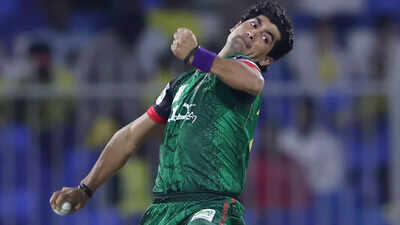Heading into spring training this year, ahead of what might become his second MVP season, Los Angeles Dodgers superstar Mookie Betts said one of his offseason projects was to bulk up.
“Losing weight equates to losing strength,” Betts told MLB.com, recalling the results of tests at Driveline Baseball, the cutting-edge performance lab he visited at the Dodgers’ recommendation. “I was just little, man, so I had to gain my weight back.”
The bulking up brought Betts all the way up to 178 pounds, per MLB.com. He said he played at 170 pounds in 2022, when he ripped 35 homers. This year, he has already surpassed that on the way to a career high. His next round-tripper will be No. 40, an extraordinary total for anyone — but especially for someone of Betts’ size.
At 5-foot-9, Betts would be just the fourth under-5-foot-10 player in MLB history to crack 40 homers in a season, joining Roy Campanella in 1953, Hack Wilson in 1930 and Mel Ott in 1929. (That’s by listed height, a corner of the baseball world with enough stretching to rival first basemen. For instance, Alex Bregman, who tallied 41 homers in 2019, is listed at 6 feet, even though he appears to be level with Betts.)
But the precise contours of history aren’t the point here so much as the historic feel of Betts’ stardom. A freakish athlete who also excelled at basketball in high school and remains a remarkably good bowler, Betts and his ever-growing laundry list of accomplishments can seem as though they were transported from a different day and age — a world of black-and-white TV, word-of-mouth exploits and larger-than-life heroes who were, in reality, everyday-life-sized.
The story of professional sports is mostly a story about getting bigger. More interest led to more money, which led to sports becoming a more dedicated career pursuit, which led to more energy focused on training and teaching the skills required, which led to a heightened search for the biggest, strongest players who could be trained and taught. It all makes sense. Baseball’s journey toward the reign of physical exceptionalism is less obvious than those of football or basketball, but it’s happening. It has been happening for generations.
“The pitchers are much better today,” Willie Mays said way back in 1970, entering the valedictory stages of his Hall of Fame career. “The most improved pitch is the slider. Everybody throws it now, and many throw it well.”
“The pitchers are bigger today,” he added, “and they throw harder.”
Many years and exponential leaps down the road, Mays’ observations would ring just as true if he made them today. The best all-around player of his era — and still a popular choice for the best all-around player ever — Mays stood 5-foot-10 and weighed about 182 pounds during his playing days, per his own accounting to the Sporting News. He hit 40 or more homers in six seasons en route to 660 career long balls and recognized the escalating difficulty, even though the league never quite caught up to his standout greatness.
Decades later, Betts is about Mays’ size, but the competition looks very different. During Mays’ peak, from 1954 to 1965, there were 18 total hitters who stood at least 6 feet tall, weighed at least 200 pounds and got at least 3,000 plate appearances (about six seasons, or what it would take to reach free agency now). During Betts’ career, since 2014, there have been 113 hitters who meet those marks.
The average measurements of the five other hitters who have reached the 40-homer threshold or are on pace to do so this season — Matt Olson, Pete Alonso, Kyle Schwarber, Shohei Ohtani and Ronald Acuña Jr. — are 6-foot-2, 223 pounds. Then there’s Betts, who sometimes looks like he’s swishing around in his uniform as he bounds around the bases at Dodger Stadium — and who currently leads the National League in OPS+.
Betts has elite athletic traits, of course. They just aren’t apparent to his tailor. His hand-eye coordination is the stuff this very specific type of legend is made of. His ultra-fast visual processing and reaction times are something approaching superpowers in a baseball landscape dominated by fastballs that go 94 mph on average.
When Betts leapt onto the prospect radar in 2013, after hitting zero homers in 72 minor-league games in 2012, minor-league manager Carlos Febles said he “recognizes pitches as well as anybody I’ve seen in this level.” That has remained astoundingly true as Betts has moved all the way up to the major-league level.
What it means, functionally, is that Betts is maximizing his physical potential more than any other hitter today. Even though his maximum exit velocities don’t stand out — at 110.1 mph, his hardest-hit ball of the season ranks 177th among qualified hitters — Betts consistently succeeds at the next-level task of putting the baseball over the fence.
In 2023, a batter’s priority list goes: swing at a good pitch, make contact, hit the ball hard, hit the ball in the air. The order changes based on the player and situation, but that’s the list. Betts is the undisputed master of doing all those things simultaneously. This season, 19% of his swings have led to balls leaving his bat at 95+ mph and an angle of 5 degrees or higher. (Aaron Judge is second at 15.5%.)
All that means: Betts hits the ball hard and in the air pretty much on demand. He achieves the basic goal of the game, despite playing against a cavalcade of competitors who are more physically imposing. In an era of measurement, of otherworldly talents such as Judge and Acuña and of more finely tuned comparisons that work to place their very modern excellence in the context of baseball history, Betts is something like the exception that proves the rule.
He would not stick out like a sore thumb in a first glance at grainy 1950s footage from the Polo Grounds or Ebbets Field. He does not stick out on the surface level of Statcast leaderboards. But in reality, Betts leaps off the field and off the screen, a pound-for-pound heavyweight whose power would play in any generation.





